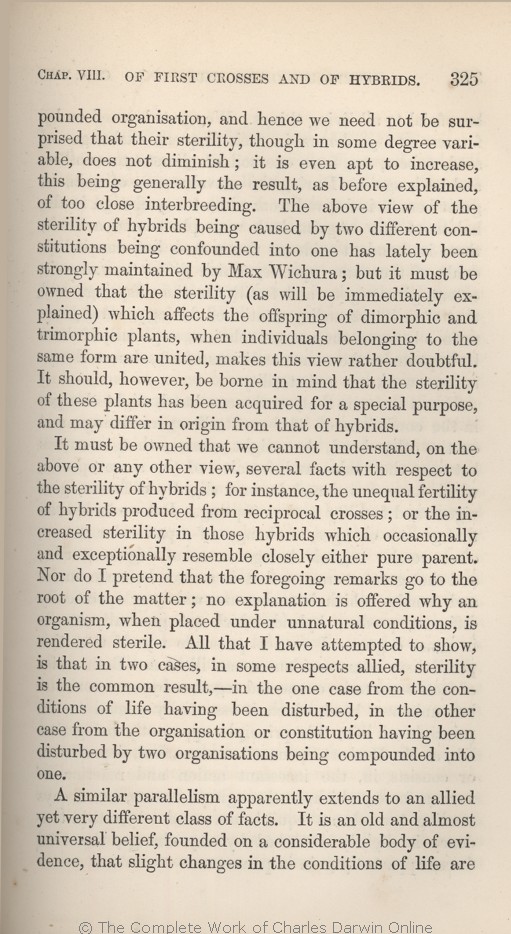organisation, and hence we need not be surprised that their sterility, though in some degree
variable, | variable, 1859 1860 1861 1869 1872 | | vari- able, 1866 |
| does not diminish; it is even apt to increase, this being generally the result, as before explained, of too close interbreeding. 1869 1872 |
| rarely diminishes. 1859 1860 1861 |
| does not diminish, but is apt to increase; this increase being perhaps intelligible, as before explained, on the principles of inheritance and from too close interbreeding. 1866 |
| different 1866 1869 | different 1872 |
| being 1869 1872 | | having been 1866 |
| confounded 1866 1869 | | compounded 1872 |
| lately 1866 1869 | lately 1872 |
| Wichura; 1866 1869 | | Wichura. 1872 |
| owned 1866 1869 | owned 1872 |
| sterility 1869 | | sterility, 1866 | sterility 1872 |
| (as will be immediately explained) 1869 |
| OMIT 1872 |
| so like in every respect to that of hybrids, 1866 |
| which 1866 1869 | which 1872 |
| affects 1866 1869 | affects 1872 |
| offspring 1869 | | illegitimate offspring 1866 | offspring 1872 |
| dimorphic 1866 1869 | dimorphic 1872 |
| trimorphic 1866 1869 | trimorphic 1872 |
| plants, 1869 | | plants 1866 | plants, 1872 |
| when individuals belonging to 1869 |
| OMIT 1872 |
| of 1866 |
| form are united, 1869 |
| OMIT 1872 |
| species (as will be immediately described), 1866 |
| makes 1866 1869 | makes 1872 |
| rather 1866 1869 | rather 1872 |
| doubtful. 1866 1869 | doubtful. 1872 |
|
|
It
must | must 1866 1869 | | must, 1859 1860 1861 1872 |
| ..... 1869 | | however, 1859 1860 1861 1872 | | also 1866 |
| owned 1866 1869 1872 | | confessed 1859 1860 1861 |
| ..... 1866 1869 1872 | | excepting 1859 1860 | | except 1861 |
| the above or any other view, 1869 1872 |
| vague hypotheses, 1859 1860 1861 |
| this or any other view, 1866 |
| matter; 1869 1872 | | matter: 1859 1860 1861 1866 |
| show, 1859 1860 1861 1866 1869 | | show 1872 |
| is 1859 1860 1861 1866 1869 | | is, 1872 |
| result,—in 1866 1869 | | result,— 1859 1861 1872 | | result, — 1860 |
| ..... 1866 1869 | | in 1859 1860 1861 1872 |
| or constitution having 1866 1869 |
| having 1859 1860 1861 1872 |
| being 1866 1869 1872 | | having been 1859 1860 1861 |
|
|
A | A 1869 1872 |
| It may seem fanciful, but I suspect that a 1859 1860 1861 1866 |
| apparently extends to 1869 |
| extends to 1859 1860 1861 1866 |
| holds good with 1872 |
| belief, 1859 1860 1861 1866 1869 | | belief 1872 |
| founded 1869 1872 | | founded, 1859 1860 1861 1866 |
| ..... 1869 1872 | | I think, 1859 1860 1861 1866 |
| that 1859 1860 1861 1866 1869 |
| which I have elsewhere given, that 1872 |
|









